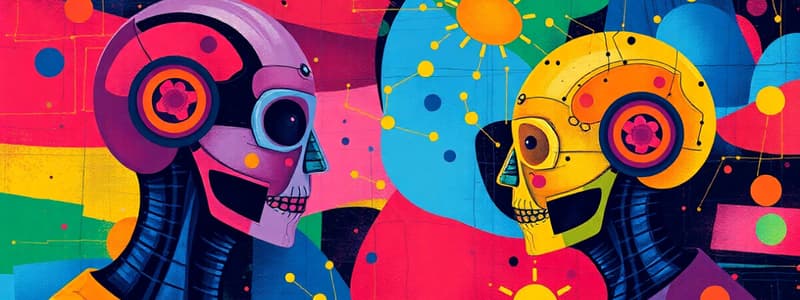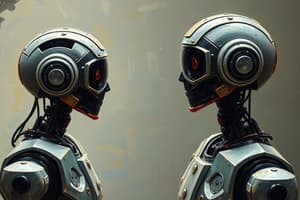Podcast
Questions and Answers
What defines an accessible environment?
What defines an accessible environment?
- An environment lacking any measurable parameters.
- An environment with unpredictable outcomes.
- An environment defined solely by its physical dimensions.
- An environment where the agent can obtain complete and accurate information. (correct)
Which of the following represents an inaccessible environment?
Which of the following represents an inaccessible environment?
- A simple maze that an agent is navigating.
- An experiment conducted in a controlled laboratory.
- A room with known temperature.
- An event happening in another part of the world. (correct)
Which two components make up an AI agent?
Which two components make up an AI agent?
- Architecture and Agent Program (correct)
- Sensors and Decision-Making
- Input and Output Mechanisms
- Data and Processing Power
What is a simple reflex agent primarily based on?
What is a simple reflex agent primarily based on?
What does the agent function map from and to?
What does the agent function map from and to?
Which type of agent incorporates knowledge of previous actions?
Which type of agent incorporates knowledge of previous actions?
What mechanism do utility-based agents use to make decisions?
What mechanism do utility-based agents use to make decisions?
Which of the following is NOT a type of AI agent mentioned?
Which of the following is NOT a type of AI agent mentioned?
What characterizes a single-agent environment?
What characterizes a single-agent environment?
Which type of environment requires an agent to continuously observe its surroundings?
Which type of environment requires an agent to continuously observe its surroundings?
What defines a discrete environment?
What defines a discrete environment?
In which scenario does an agent operate in a known environment?
In which scenario does an agent operate in a known environment?
How does a multi-agent environment differ from a single-agent environment?
How does a multi-agent environment differ from a single-agent environment?
Which of the following is an example of a continuous environment?
Which of the following is an example of a continuous environment?
Which of the following statements accurately reflects a static environment?
Which of the following statements accurately reflects a static environment?
What distinguishes an unknown environment for an agent?
What distinguishes an unknown environment for an agent?
What is the primary function of a model-based reflex agent?
What is the primary function of a model-based reflex agent?
What differentiates goal-based agents from other types of agents?
What differentiates goal-based agents from other types of agents?
Which factor is crucial for utility-based agents when selecting an action sequence?
Which factor is crucial for utility-based agents when selecting an action sequence?
What role does the 'critic' play in a learning agent?
What role does the 'critic' play in a learning agent?
What is a characteristic feature of a learning agent?
What is a characteristic feature of a learning agent?
How does a model-based reflex agent deal with partial observability?
How does a model-based reflex agent deal with partial observability?
Which statement best describes the actions of a goal-based agent?
Which statement best describes the actions of a goal-based agent?
What is the primary objective of utility-based agents in action selection?
What is the primary objective of utility-based agents in action selection?
What defines the optimal solution in problem solving?
What defines the optimal solution in problem solving?
What is the primary purpose of standardized/toy problems?
What is the primary purpose of standardized/toy problems?
How many states are there in a simple two-cell vacuum world?
How many states are there in a simple two-cell vacuum world?
What characteristic distinguishes real-world problems from standardized/toy problems?
What characteristic distinguishes real-world problems from standardized/toy problems?
In the context of the vacuum world problem, what can obstruct an agent's movement?
In the context of the vacuum world problem, what can obstruct an agent's movement?
What is the structure used to represent the vacuum world in the provided example?
What is the structure used to represent the vacuum world in the provided example?
What does the agent in the vacuum world do?
What does the agent in the vacuum world do?
What does the state space graph represent in the vacuum world?
What does the state space graph represent in the vacuum world?
What is the primary goal of Artificial Intelligence (AI)?
What is the primary goal of Artificial Intelligence (AI)?
Which of the following is NOT a core value of CHRIST Deemed to be University?
Which of the following is NOT a core value of CHRIST Deemed to be University?
What is the key characteristic of an "artificial" element within the context of AI?
What is the key characteristic of an "artificial" element within the context of AI?
What is the primary purpose of an Intelligent Agent in AI?
What is the primary purpose of an Intelligent Agent in AI?
What is the difference between "intelligence" and "artificial intelligence"?
What is the difference between "intelligence" and "artificial intelligence"?
What is the primary difference between a problem-solving agent and a traditional computer program?
What is the primary difference between a problem-solving agent and a traditional computer program?
According to the content, what is the main focus of the "Introduction to AI" unit?
According to the content, what is the main focus of the "Introduction to AI" unit?
Based on the text, what is the primary characteristic of "Good behavior" in an Intelligent Agent?
Based on the text, what is the primary characteristic of "Good behavior" in an Intelligent Agent?
What type of environment is characterized by an agent's inability to completely determine the next state based solely on its current state and chosen action?
What type of environment is characterized by an agent's inability to completely determine the next state based solely on its current state and chosen action?
Which environment type requires an agent to maintain a memory of past actions to make informed decisions?
Which environment type requires an agent to maintain a memory of past actions to make informed decisions?
In what kind of environment is an agent's sensor capable of perceiving the complete state of the world at any given time?
In what kind of environment is an agent's sensor capable of perceiving the complete state of the world at any given time?
Which of the following is NOT a characteristic of an environment from the perspective of an agent, as per Russell and Norvig?
Which of the following is NOT a characteristic of an environment from the perspective of an agent, as per Russell and Norvig?
When an environment is considered 'unknown,' what does that mean for the agent?
When an environment is considered 'unknown,' what does that mean for the agent?
What type of environment is characterized by a series of independent, one-shot actions where the agent only needs the current information to make a decision?
What type of environment is characterized by a series of independent, one-shot actions where the agent only needs the current information to make a decision?
An environment where an agent's actions have a predictable outcome, allowing for complete control over the next state, is considered:
An environment where an agent's actions have a predictable outcome, allowing for complete control over the next state, is considered:
Which of the following is a key characteristic of an environment that is considered 'accessible'?
Which of the following is a key characteristic of an environment that is considered 'accessible'?
Flashcards
Fully Observable Environment
Fully Observable Environment
An environment where an agent can sense the complete state at all times.
Partially Observable Environment
Partially Observable Environment
An environment where an agent cannot access the complete state at all times.
Deterministic Environment
Deterministic Environment
An environment where the next state is completely determined by current state and action.
Stochastic Environment
Stochastic Environment
Signup and view all the flashcards
Episodic Environment
Episodic Environment
Signup and view all the flashcards
Sequential Environment
Sequential Environment
Signup and view all the flashcards
Single-Agent Environment
Single-Agent Environment
Signup and view all the flashcards
Multi-Agent Environment
Multi-Agent Environment
Signup and view all the flashcards
Artificial Intelligence
Artificial Intelligence
Signup and view all the flashcards
Intelligent Agents
Intelligent Agents
Signup and view all the flashcards
Nature of Environments
Nature of Environments
Signup and view all the flashcards
Good Behavior in AI
Good Behavior in AI
Signup and view all the flashcards
Problem-Solving Agents
Problem-Solving Agents
Signup and view all the flashcards
Definition of Intelligence
Definition of Intelligence
Signup and view all the flashcards
Artificial vs. Natural
Artificial vs. Natural
Signup and view all the flashcards
Structure of Agents
Structure of Agents
Signup and view all the flashcards
Static Environment
Static Environment
Signup and view all the flashcards
Dynamic Environment
Dynamic Environment
Signup and view all the flashcards
Discrete Environment
Discrete Environment
Signup and view all the flashcards
Continuous Environment
Continuous Environment
Signup and view all the flashcards
Known Environment
Known Environment
Signup and view all the flashcards
Unknown Environment
Unknown Environment
Signup and view all the flashcards
Accessible Environment
Accessible Environment
Signup and view all the flashcards
Inaccessible Environment
Inaccessible Environment
Signup and view all the flashcards
Structure of an AI Agent
Structure of an AI Agent
Signup and view all the flashcards
Architecture of an Agent
Architecture of an Agent
Signup and view all the flashcards
Agent Program
Agent Program
Signup and view all the flashcards
Agent Function
Agent Function
Signup and view all the flashcards
Simple Reflex Agents
Simple Reflex Agents
Signup and view all the flashcards
Types of Agents
Types of Agents
Signup and view all the flashcards
Condition Action Rule
Condition Action Rule
Signup and view all the flashcards
Model-based Reflex Agents
Model-based Reflex Agents
Signup and view all the flashcards
Goal-based Agents
Goal-based Agents
Signup and view all the flashcards
Utility-based Agents
Utility-based Agents
Signup and view all the flashcards
Learning Agent
Learning Agent
Signup and view all the flashcards
Learning Element
Learning Element
Signup and view all the flashcards
Critic
Critic
Signup and view all the flashcards
Partial Observability
Partial Observability
Signup and view all the flashcards
Optimal Solution
Optimal Solution
Signup and view all the flashcards
Standardized Problem
Standardized Problem
Signup and view all the flashcards
Real-world Problems
Real-world Problems
Signup and view all the flashcards
Vacuum World Problem
Vacuum World Problem
Signup and view all the flashcards
State Space Graph
State Space Graph
Signup and view all the flashcards
World State
World State
Signup and view all the flashcards
Number of States
Number of States
Signup and view all the flashcards
Agent Movement
Agent Movement
Signup and view all the flashcards
Study Notes
Artificial Intelligence (AI) Overview
- AI is a method of making computers, robots, or software think like humans.
- This involves mimicking human problem-solving and decision-making abilities.
- AI leverages computers and machines to achieve this result.
Core Concepts
-
Intelligence: The ability to acquire and apply knowledge and skills. Psychologists see it as learning, problem-solving, and recognizing problems.
-
Agent: Anything that perceives the environment via sensors and acts upon it through actuators. These can be people, robots, or computer programs.
- Structure of Agents: Combining architecture (physical/software elements) with a program (instructions).
-
Environment: Everything that surrounds the agent, excluding the agent itself.
- Nature of Environments:
- Fully observable vs Partially observable: How much information is directly available to the agent.
- Static vs Dynamic: Does the environment change while the agent is making decisions.
- Discrete vs Continuous: Is it possible to take an infinite number of steps or actions; are there a finite number.
- Deterministic vs Stochastic: Can the future of the environment's state be determined from the agent's current state and action.
- Single-agent vs Multi-agent: One agent acting, or multiple agents interacting in the same environment.
- Episodic vs Sequential: Does the agent need to store information about past actions/states.
- Known vs Unknown: Does the agent know the rules/mechanisms of the environment from the outset.
- Accessible vs Inaccessible: Is full access to the environment's state permitted.
- Nature of Environments:
-
Sensors: Devices that detect changes in the environment and send information.
-
Actuators: Mechanisms that convert energy into motion—responsible for performing actions.
-
Effectors: The devices that affect the environment (e.g., legs, wheels, arms).
-
PEAS Representation: A model for describing properties of an AI agent.
- P: Performance Measure (e.g., time efficiency, accuracy)
- E: Environment
- A: Actuators
- S: Sensors
Learning Agents
- Agents that can learn from past experiences.
- They start with basic knowledge and adapt.
- Key components:
- Learning Element: Improves based on experience.
- Critic: Provides feedback on agent performance.
- Performance Element: Selects actions in the environment.
- Problem Generator: Suggests useful actions to improve learning.
Problem Solving Agents
-
Agents that decide actions by finding sequences that lead to a desired state or solution.
-
Use search in their computation to decide.
-
Problem Formulation Components needed:
- Initial State: Agent's starting point.
- Actions: Possible agent actions.
- Transition Model: Results of each action in the environment.
- Goal Test: Identifies if the current state is the goal state.
- Path Cost: Numerical cost of each path to goal.
-
Types of Problems:
- Standardized/Toy Problems: Designed for demonstration/testing, simply described.
- Real-world Problems: More complex tasks with the need of thorough solutions.
Example Problems
- Vacuum World Problem: Agents move on a grid to suck up dirt.
- Grid World Problem: Agents navigate a matrix of cells that may contain obstacles.
- Eight Puzzle Problem: Tiles must be rearranged to meet a goal state (order).
Studying That Suits You
Use AI to generate personalized quizzes and flashcards to suit your learning preferences.




